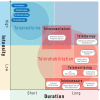Telerehabilitation: State-of-the-Art from an Informatics Perspective
- PMID: 25945164
- PMCID: PMC4296781
- DOI: 10.5195/ijt.2009.6015
Telerehabilitation: State-of-the-Art from an Informatics Perspective
Abstract
Rehabilitation service providers in rural or underserved areas are often challenged in meeting the needs of their complex patients due to limited resources in their geographical area. Recruitment and retention of the rural clinical workforce are beset by the ongoing problems associated with limited continuing education opportunities, professional isolation, and the challenges inherent to coordinating rural community healthcare. People with disabilities who live in rural communities also face challenges accessing healthcare. Traveling long distances to a specialty clinic for necessary expertise is troublesome due to inadequate or unavailable transportation, disability specific limitations, and financial limitations. Distance and lack of access are just two threats to quality of care that now being addressed by the use of videoconferencing, information exchange, and other telecommunication technologies that facilitate telerehabilitation. This white paper illustrates and summarizes clinical and vocational applications of telerehabilitation. We provide definitions related to the fields of telemedicine, telehealth, and telerehabilitation, and consider the impetus for telerehabilitation. We review the telerehabilitation literature for assistive technology applications, pressure ulcer prevention, virtual reality applications, speech-language pathology applications, seating and wheeled mobility applications, vocational rehabilitation applications, and cost-effectiveness. We then discuss external telerehabilitation influencers, such as the positions of professional organizations. Finally, we summarize clinical and policy issues in a limited context appropriate to the scope of this paper.
Keywords: Telehealth; Telemedicine; Telepractice; Telerehabilitation.
Figures
References
-
- Demiris G, Shigaki CL, Schopp LH. An evaluation framework for a rural home-based telerehabilitation network. Journal of Medical Systems. 2005;29(6):595–603. - PubMed
-
- Feng X, Winters J. An interactive framework for personalized computer-assisted neurorehabilitation. IEEE Transactions on Information Technology in Biomedicine. 2007;11(5):518–526. - PubMed
-
- Heuser A, Kourtev H, Winter S, Fensterheim D, Burdea G, Hentz V, et al. Telerehabilitation using the Rutgers Master II Glove following carpal tunnel release Surgery: Proof-of-concept. IEEE Transactions on Neural Systems and Rehabilitation Engineering. 2007;15(1):43–49. - PubMed
-
- Hill AJ, Theodoros DG, Russell TG, Cahill LM, Ward EC, Clark KM. An Internet-based telerehabilitation system for the assessment of motor speech disorders: a pilot study. American Journal of Speech-Language Pathology. 2006;15(1):45–56. - PubMed
-
- Hoenig H, Sanford JA, Butterfield T, Griffiths PC, Richardson P, Hargraves K. Development of a teletechnology protocol for in-home rehabilitation. Journal of Rehabilitation Research & Development. 2006;43(2):287–298. - PubMed
LinkOut - more resources
Full Text Sources

